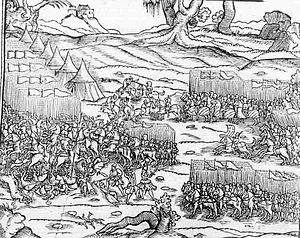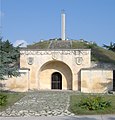Battle of Varna
| date | November 10, 1444 |
|---|---|
| place | Varna , Bulgaria |
| output | Victory of the Ottomans |
| Parties to the conflict | |
|---|---|
| Commander | |
| Troop strength | |
| up to 60,000 men | up to 30,000 men |
| losses | |
|
up to 8,000 men |
up to 11,000 men |
The Battle of Varna took place on November 10, 1444 between Ottoman troops and an army of crusaders . The Ottomans under Sultan Murad II destroyed the army of the crusaders, that of Władysław III. , King of Poland and Hungary , and Johann Hunyadi was commanded. King Władysław was killed in this battle.
Historical classification: the last crusade
Encouraged by the unsuccessful sieges of Belgrade in 1440 and Sibiu in 1442, the uprising of the Albanians under Prince Skanderbeg that began in 1443, and secured by an alliance with Serbia and Wallachia , whose princes Đurađ Branković and Vlad II Dracul refused allegiance to the Sultan In 1443 a Polish-Hungarian crusader army broke out from the Serbian Smederevo with the aim of preventing the threatened conquest of Constantinople by the Turks. In addition, the Pope had already called for a crusade at the Council of Florence in 1439 after a Catholic-Orthodox church union . In fact, despite a preliminary victory at Sofia in 1443, there was little more than a defense of the Hungarian borders.
Course of the crusade
Militarily on the defensive, Turks and Hungarians negotiated a peace treaty in 1444. Cardinal Giuliano Cesarini, however, gave birth to King Władysław III. of his oath, which then continued the march to the Black Sea. Instead of the Serbs who left, Venice and Burgundy joined the alliance, although the Burgundians did not participate in the crusade army, but provided the bulk of the crusade fleet initiated by the Pope and commanded by his nephew.
After the capture and destruction of the key fortress of Shumen and the further advance of the crusaders, the sultan and his army crossed the European bank of the Bosporus and marched towards the crusaders in forced marches. The crusade fleet could not prevent the transfer of the Turkish army from Asia Minor, the sources contradicting each other about the reasons for this. Allegedly, a storm is said to have prevented the further advance of the crusade fleet, but the lack of coordination between the army and the fleet as well as supply problems for the same should also have played a role in the inactivity of the fleet that should not be underestimated. Finally, it was also said that the Venetians and Genoese even helped the sultan to translate his army for good pay because, due to their trade interests in the eastern Mediterranean, they could not have any real interest in disrupted diplomatic relations with the Ottoman Empire and therefore only half-heartedly supported the crusade should.
In the Polish-Hungarian army, the rivalry between the Polish king Władysław III increased. (as Ulaszlo I. also Hungarian king) and his Hungarian-Transylvanian voivod Johann Hunyadi , who was said to prefer to rule as an imperial administrator without a king. In the battle, the superior cavalry of the Crusaders initially prevailed and fought back both the Turkish skirmishers and the heavy cavalry of the Sipahi . The Turks were already turning to flee when Władysław III, who was not yet satisfied with what had been achieved, launched a final cavalry attack that was as daring as it was risky and thoughtless. The Janissaries, however, withstood the attack of the Hungarian cavalry, in which Władysławs III. Horse fell and he was killed immediately after the fall. The resulting panic among the crusaders led to their headless flight and ultimately brought victory to the Ottoman troops. Hunyadi managed to escape from the battlefield with some difficulty, while the papal cardinal legate Giuliano Cesarini, who had also taken part in the battle, was killed during the chaotic retreat of the crusader army.
consequences
Since the Turks first moved south towards Greece, Hunyadi was able to prepare the continuation of the fight. Together with Serbian troops, the Hungarians marched in support of the Albanians, but were defeated again in 1448 in the second battle on the Amselfeld . The Turkish conquest of Constantinople in 1453, the rest of Serbia in 1459, southern Greece ( Duchy of Athens in 1456, Despotate of Morea in 1460), Romanian Wallachia, which was forced into a vassal relationship in 1462, Bosnia in 1463 and Albania in 1478 were no longer opposed. Only Belgrade, which had been besieged again, was successfully defended by Hunyadi in 1456, the city was not conquered by the Turks until 1521 and fell immediately to the Ottoman Empire.
reception
In history painting, the Polish painters Jan Matejko and Stanisław Chlebowski dealt with the Battle of Varna .
literature
- Franz Babinger : From Amurath to Amurath. Prelude and aftermath of the Battle of Varna <1444>. In: Oriens 3,2 (1950), pp. 229-265.
- John Jefferson: The Holy Wars of King Wladislas and Sultan Murad. The Ottoman-Christian Conflict from 1438-1444 (= History of Warfare. Volume 76). Brill, Leiden / Boston 2012, ISBN 978-90-04-21904-5 .
- Günter Kettermann: Atlas on the history of Islam. Scientific Book Society, Darmstadt 2001, ISBN 978-3-534-14118-0 .
- Franz Georg Maier (ed.): Byzanz (= Fischer Weltgeschichte . Volume 13). Fischer Taschenbuch, Frankfurt am Main 1973, p. 403 f.
- Helga Weck, Sándor Zsilinszky: Pocket Lexicon Hungary. Bibliographical Institute, Leipzig 1981.
Web links
Remarks
- ↑ See: Klaus-Peter Matschke: Das Kreuz und der Halbmond. The history of the Turkish wars. Artemis & Winkler, Düsseldorf-Zurich 2004, ISBN 3-538-07178-0 , pp. 143-149 and Franz Babinger: Mehmed the Conqueror. World striker at a turning point. Piper, Munich 1987, ISBN 3-492-10621-8 , p. 37 f.
Coordinates: 43 ° 13 ′ 0 ″ N , 27 ° 53 ′ 0 ″ E






